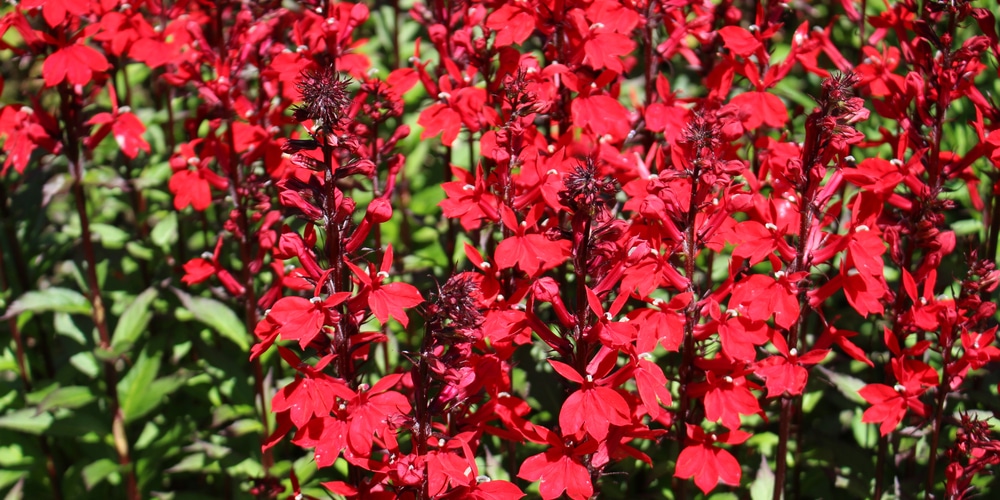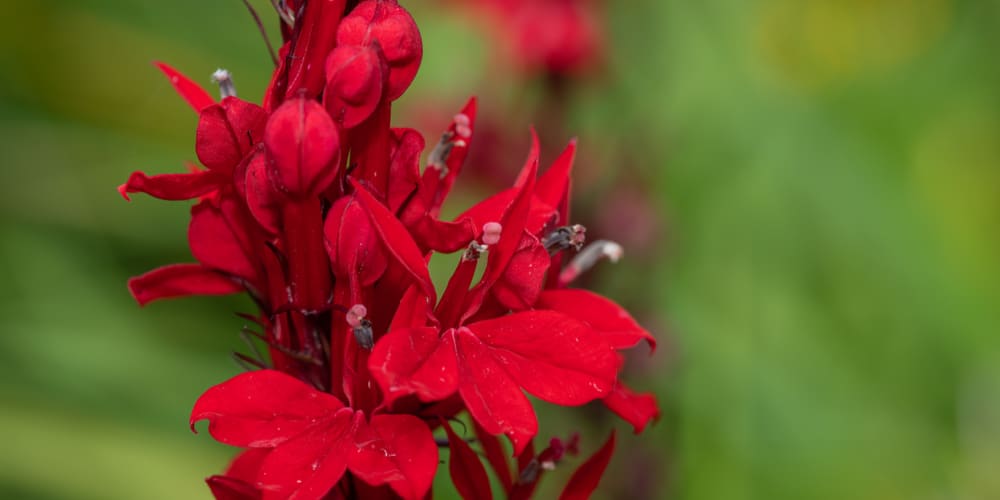Standing 2 to 3 feet tall and 12 inches wide, the Lobelia Vulcan Red is an improvement over Queen Victoria. It creates a dense mound of deep burgundy foliage with red blooms. It’s well-branched, creating a uniform habit with increased blooms from mid-summer into fall. Here is a complete guide about caring for a Lobelia Vulcan Red plant.
Lobelia Vulcan red facts
- Scientific Name: Lobelia speciosa
- Plant Type: Perennial
- Sun Requirements: Full sun to partial shade
- USDA Hardiness Zones: 6 – 10
- Soil PH Range: Slightly acidic, neutral, and slightly alkaline
- Soil Type: Sandy loam to clay loam
- Water Needs: High
What You Need to Know About Lobelia Vulcan Red
The Lobelia Vulcan Red forms entire, well-branched stems. Often found along woodland paths, it’s well suited for use around ponds, streams, rain gardens, and other moist areas.
It can handle more sun than the classic varieties. But in drier locations, some shade is beneficial. This perennial Lobelia bears cardinal red flowers on strong stems against deep purple foliage. Excellent for use in floral displays or for filling up a flower border, it’s attractive to butterflies, and hummingbirds.
The Lobelia Vulcan Red is an excellent border plant that performs best in deep, rich moisture retentive soil. If the soil has enough moisture, the plant will thrive in the full sun. However, in drier soils, position the plant in part shade.
Lobelia Vulcan Red plants add vertical interest to the landscape which makes it perfect for city, cottage or coastal gardens. The plant also makes a great addition to beds and borders that are near streams and ponds.
The Vulcan Red thrives in bog gardens and can tolerate brief flooding. In cold winter climates, we recommend applying root mulch. This helps to prevent root heaving and protect the root system. The mulch also allows the soil to retain moisture.
Lobelia speciosa is a major toxin. This is because it contains lobeline, an alkaloid, and if ingested, it is fatal. So, we recommend that you be cautious when planting, especially if you’ve kids or pets.
How to Care for Lobelia Vulcan Red
Here’s everything you need to know about growing and caring for a thriving Lobelia Vulcan Red.
Light
The Lobelia Vulcan Red is more adaptable than other Lobelia. However, it will thrive in the full sun (6+ hours) and part shade (4 to 6 hours). If you’re planting the Lobelia Vulcan Red in moisture-rich soil, then you can allow the plants to thrive in the sun. However, if you grow them in drier soils, plant them in part shade or full shade (4 hours).
Western and southern sides of buildings are usually the sunniest. The only exception is when the buildings are very close together. As such, the buildings cast shadows into neighboring properties. The good news is the Lobelia Vulcan Red can thrive with a little less sunlight but may not flower as heavily nor will its foliage be vibrant.
To keep the plant looking good, trim and remove the spent blossoms. Cut back the plant by half at the end of its bloom period. By doing so, you keep the Lobelia Vulcan Red from looking messy. Also, it encourages a new flush of blooms.
Water and Soil Needs
Keep the soil evenly moist by watering the plants regularly, especially during hot summer months. If your Lobelia Vulcan Red plants are container grown, you need to water them daily. This helps to maintain the soil moisture consistency.
About an inch of water per week is fine. We also recommend adding compost to your soil. This will improve your soil water holding capability as well as its texture. Adding a 3-inch layer of mulch will also help to maintain soil moisture. In fact, studies have proven that mulched plants grow faster.
Lobelia Vulcan Red prefers sandy loam to clay loam soil. It should be fertile and evenly moist.
Temperature Requirements
The Lobelia Vulcan Red is hardy in zones 6 – 10. Generally, the plant is hardy to 5 to 14 degrees F ( -15 to -10 C). You can overwinter perennials such as the Lobelia Vulcan Red. While the leaves will die and the stems get soft, feeding them in later winter to early spring will allow the plants to bounce back quickly.
Fertilizer
You can fertilize the plant using water-soluble, quick-release fertilizers or slow-release fertilizers. Use water-soluble fertilizers every two weeks during the growing season. For the slow-release fertilizers, add to the soil during the growing season. Remember to follow the label directions for each case.
Common Diseases
The most common garden pests that attack Lobelia Vulcan Red plants are snails and slugs. These voracious feeders eat holes in leaves, devour the seedlings and tender plants, plus stripping entire stems.
To keep these pests away, clean your garden. Start by eliminating hiding places such as tarps, overturned pots, and leaf debris. Don’t forget heavy mulches and ground cover in shady places provide protection to these pests. We recommend setting up beer traps from late spring through fall.
Leaf spots are usually caused by bacteria or fungi. Normally, black or brown patches and spots appear on the leaves with a yellow-edged appearance. To prevent the spread of the infection, remove the infected leaves when the plant is dry.
Remove all the leaves collecting around the base of the plant. Avoid overhead irrigation. Instead, direct the water at the soil level.
Propagation
Here are the steps involved in properly propagating Lobelia Vulcan Red.
1. By Seeds
You can propagate by seed sown at 15 to 18 degrees C in late winter. Germination takes two weeks but can take longer at lower temperatures. Allow the seeds to mature enough before transplanting outdoors.
2. By Cuttings
If growing the Lobelia Vulcan Red by division, we recommend you do so in spring. Move the parent plant outdoors and place it where it continues to receive lots of sunlight and water.
After a couple of weeks, move the seedlings to a warmer position. Once the new growth appears, plant the cuttings in small pots filled with sandy loam or clay loam soil. In a short time, the roots should develop. Now, move the cuttings to permanent containers or in your garden with moisture-rich soil.

